Gumroad vs. Podia (+ dealbreakers) – decide in 7 minutes

If you’re struggling to choose between Gumroad and Podia, the chances are that you’re looking to sell digital products online.
Both Gumroad and Podia have their pros and cons, but the truth is that they are pretty similar (even though, not quite the same). So, there’s really no use comparing all of their features one by one. Instead, we’ll try to show only the key differences and main dealbreakers that could help you decide between these two seemingly good options.
Ready to get started? Let’s jump in!
Quick breakdown: Gumroad vs. Podia
In essence, both Gumroad and Podia are eCommerce platforms that help creators sell digital products. However, there are still some critical differences that you should know about before choosing one over the other.
For one, even though you can use Podia to sell almost any digital product, it allows you to create online courses directly on the platform. Apart from more advanced store customization, Podia also offers some built-in marketing tools including upselling and cross-selling, product bundles, discounts, and affiliate marketing.
Gumroad, on the other hand, is much easier to set up. It mostly works as a checkout solution for digital creators to accept payments in exchange for downloads. Plus, even though Gumorad doesn’t offer as many built-in features, it has one advantage over Podia — the possibility to sell physical products (including print-on-demand integrations).
Plus, although both platforms have transaction fees, Gumroad’s free plan doesn’t come with as many limitations as Podia’s.
Going on, we’ll take a closer look at both platforms’ functionality and usability and point out all of the deal-breaking differences. We’re also going to include a third platform for comparison — Sellfy. Just so you can clearly see how Gumroad and Podia not only compare to each other, but to other options in the market.
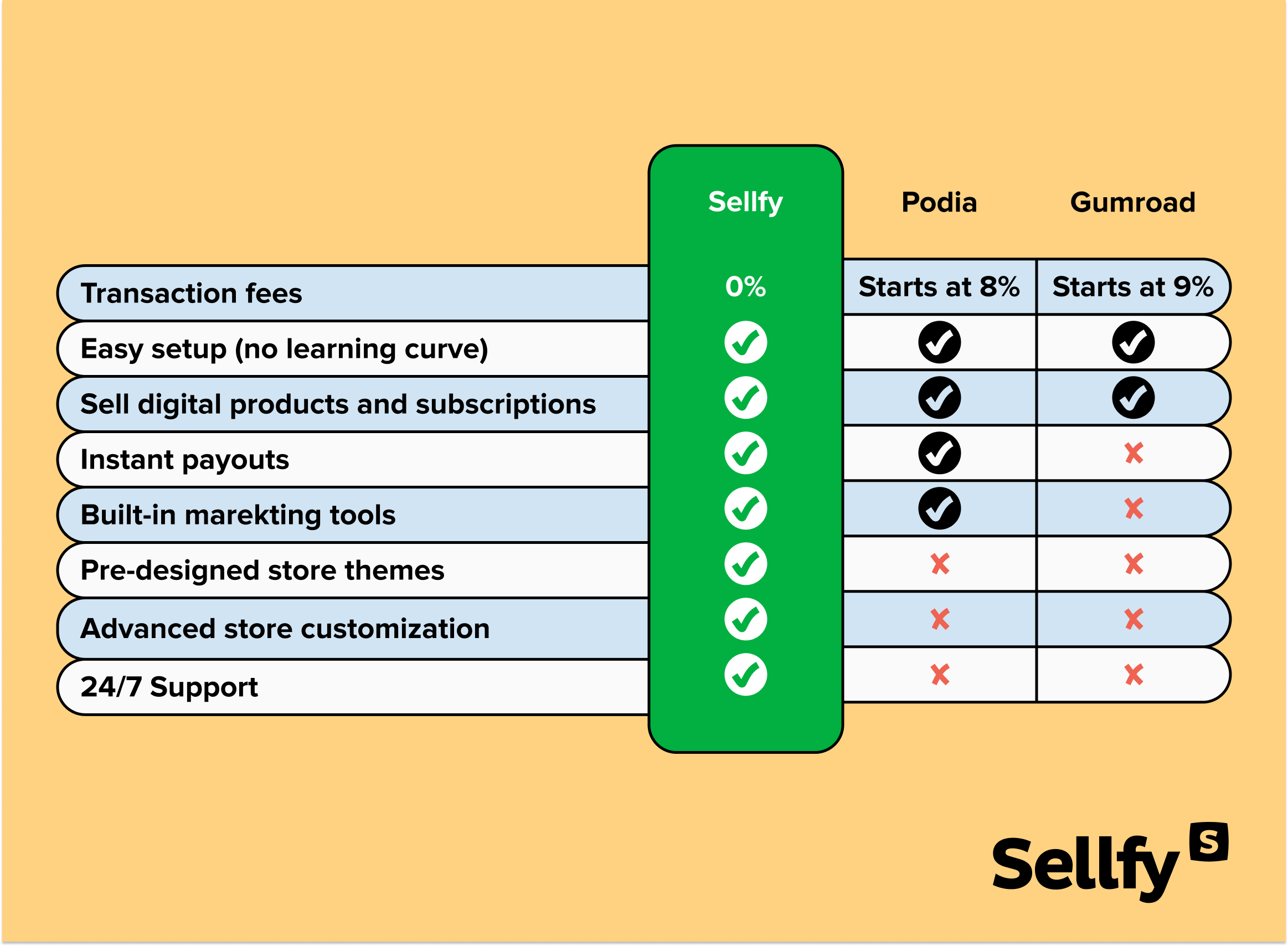
Gumroad and Podia are similar (in a way)
Built with beginners in mind, both Podia and Gumroad provide a basic set of tools to kick-start an online business. In other words, both platforms put simplicity and ease of use above anything else.
Sure, both eCommerce platforms allow you to create an online store, upload your products, and promote themes with the help of coupon codes, freebies, and email marketing. However, their ultimate goal is to help you to build a basic checkout page for selling eBooks, online courses, and other digital products.
At first glance, both platforms appear to be quite similar, but there are still things worth considering before you make your final choice.
Why would you choose Gumroad over Podia?
Sure, we love Gumroad for its simple interface and effortless setup. But, here are some real reasons for choosing Gumroad over Podia.
1. No hassle with monthly fees (sort of)
Gumroad doesn’t have a monthly or yearly subscription fee. It means that you can sell your products and get access to all available functionality without committing to a paid subscription.
Sure, Podia has a free plan too, but it has a lot of limitations that we’ll cover later.
When compared to Podia, Gumroad’s free plan come with many benefits including being able to sell an unlimited number of products, sending newsletters, issuing coupon codes, and others.

2. It takes minutes to set up a store
Gumroad is the absolute winner in terms of usability.
It offers a simple interface and a setup process that gives you a head start without having to spend hours configuring your online store. Of course, you don’t need to be a tech guru to work it out — everything is drag-and-drop.
So, if you’re looking for a way to sell subscriptions or digital downloads right this second — Gumroad’s definitely one way to do it.
But beware!
Such simplicity doesn’t come for free. And by this, I mean not only extreme transaction fees but also a lack of features and limited integration possibilities.
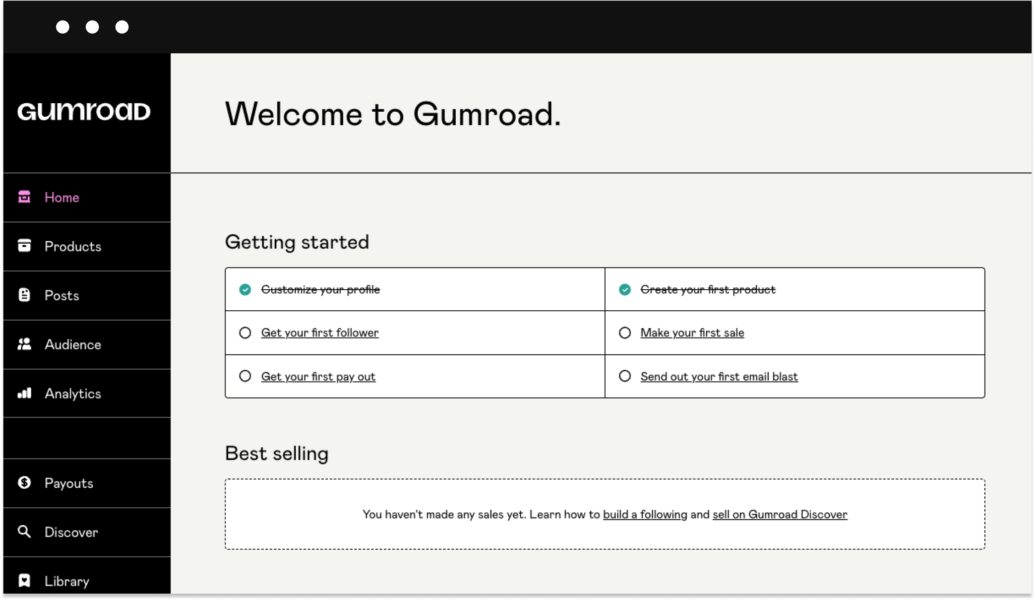
3. Gumorad Discover can help with promoting your products
Of course, we can’t compare Podia to Gumroad without mentioning one of Gumroad’s coolest features — Gumroad Discover.
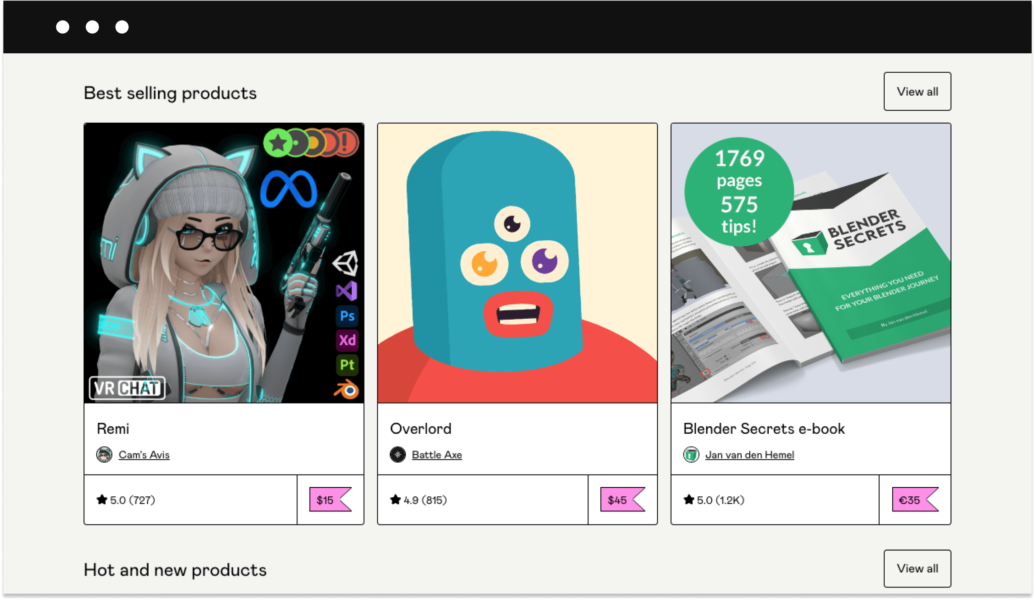
Gumroad Discover is a creative marketplace (just like Etsy, but more inclined towards digital products). In essence, it helps Gumroad users to put their products in front of potential customers by recommending them to people browsing the marketplace.
Not for free, of course.
You’ll be charged an extra 10% transaction fee for featuring your product on the Gumroad Discover marketplace. Is it worth it? We’ll leave it for you to decide.
The main disadvantage of Gumroad
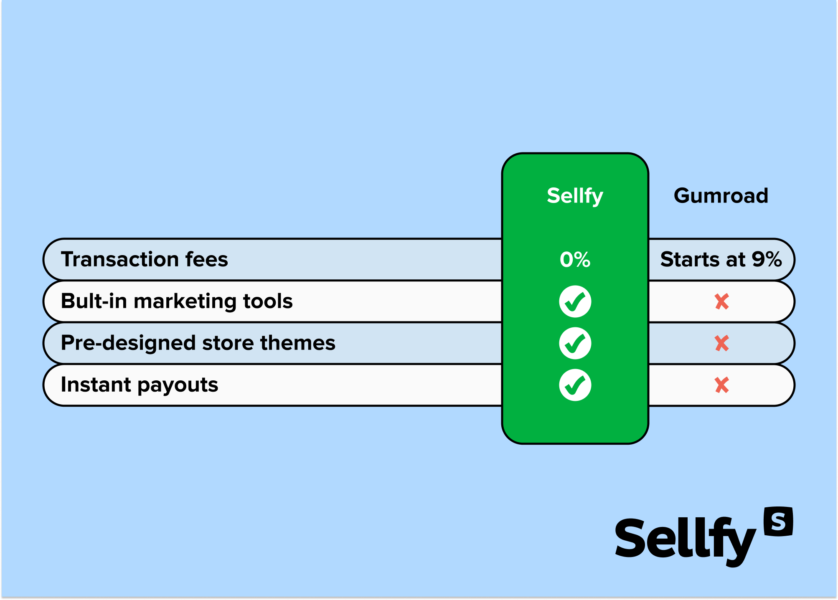
All things considered, Gumroad seems like a great eCommerce platform for selling digital products. But, there are several limitations that you should be aware of before signing up.
1. It’s only free until you sell something
Even though Gumroad claims to be a free eCommerce platform, it’s not entirely true.
As soon as you start selling, you’ll be charged an extreme 10% commission +30¢ fee for each transaction.
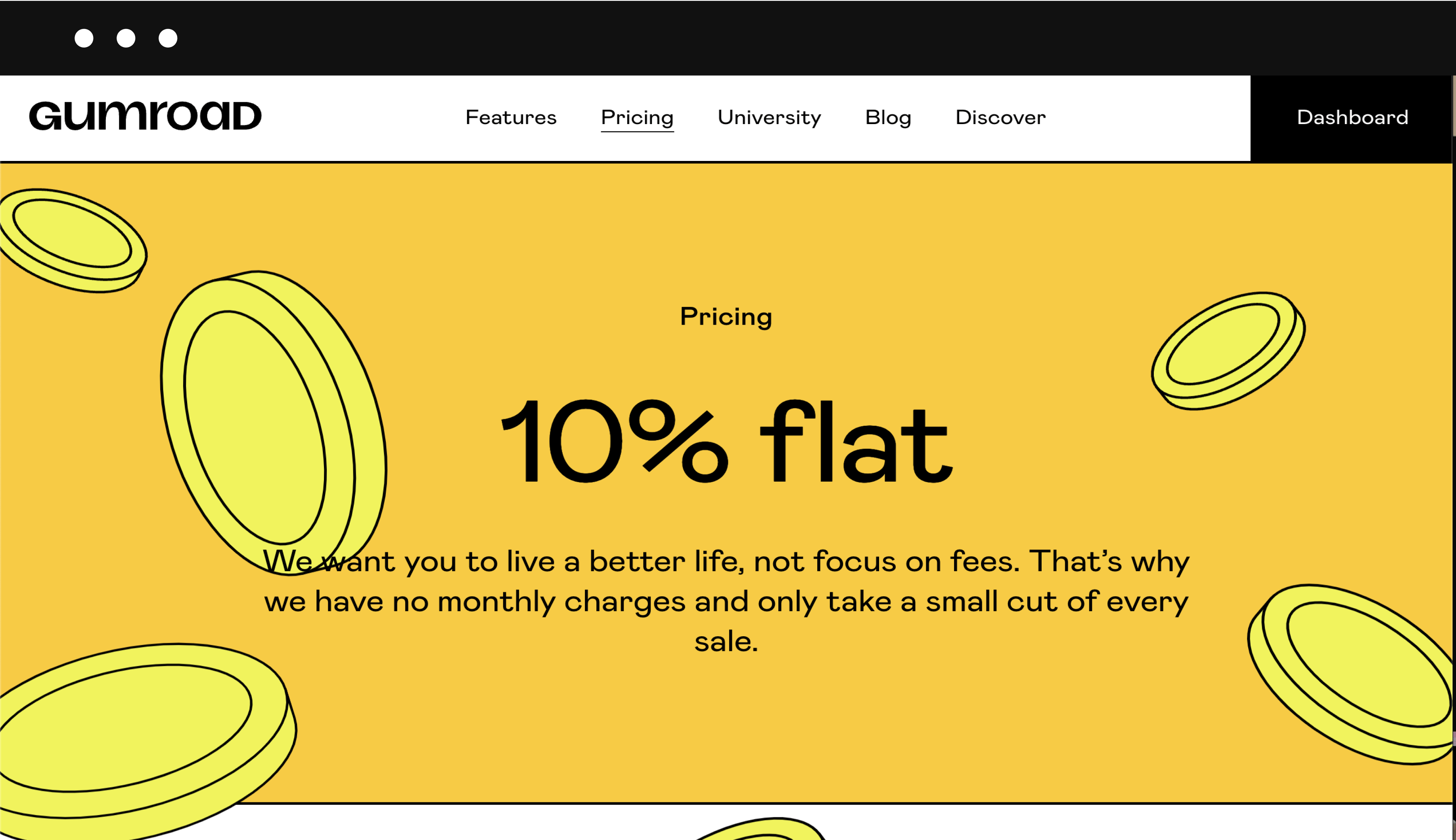
Doesn’t seem so crazy? Now, let’s think about it again:
Let’s imagine that you’re selling a $100 product. It means that once you sell something, Gumroad will keep $10 from each sale. So, if you make five sales a month, you can say goodbye to as much as $50.
It’s just something to keep in mind when comparing these two combinations: free account + transaction fees vs. flat monthly fees without transaction fees.
2. No themes, no customization, zero personality
Let’s just say that store customization isn’t one of Gumroad’s strongest features.
So, if you’re looking for an eCommerce platform with a lot of customization options, Gumroad may not be the right choice.
It’s not that there aren’t enough customization possibilities, it’s that you can hardly customize anything at all. There are no store themes to choose from, which means that your page won’t be different from hundreds of other checkout pages powered by Gumroad.
You can add some custom fields to the checkout form, customize the virtual receipt, add a custom domain, create product categories, and change some colors, but that’s about it.
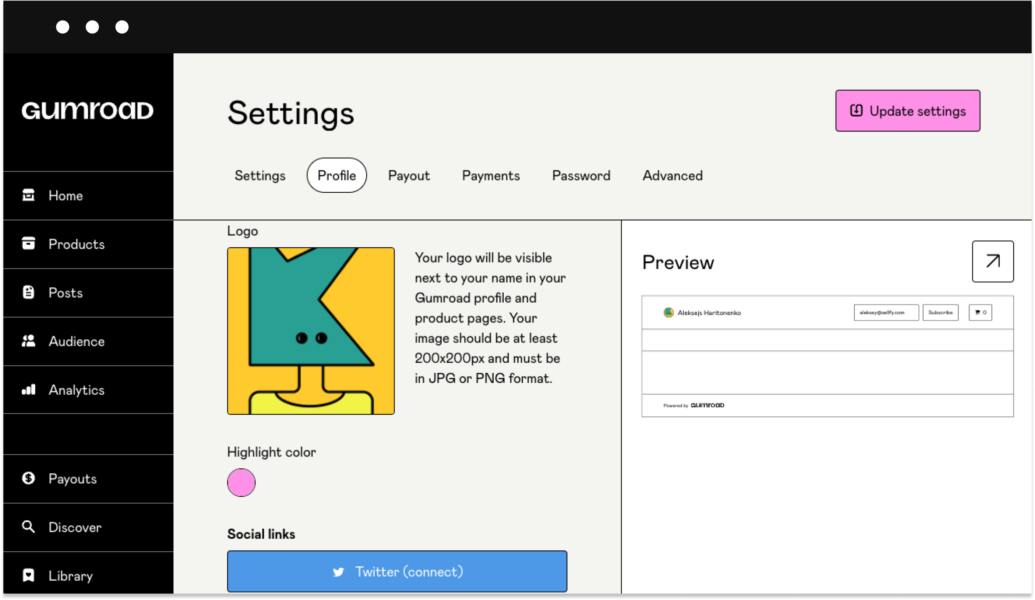
3. No more PayPal payouts
In October 2024, Gumroad and PayPal parted ways, leaving creators without the option to receive payouts through PayPal. This shift has major implications, especially for creators who relied on PayPal for its convenience and global reach.
Now, payouts are limited to bank transfers, which aren’t available in all countries. If you’re in one of these “unsupported” regions, you might have to jump through hoops, like adjusting country settings, just to access your earnings. Additionally, the absence of PayPal could impact sales, as many customers prefer it over other payment methods. For those who prefer or depend on PayPal, Gumroad’s recent changes could be a significant drawback.
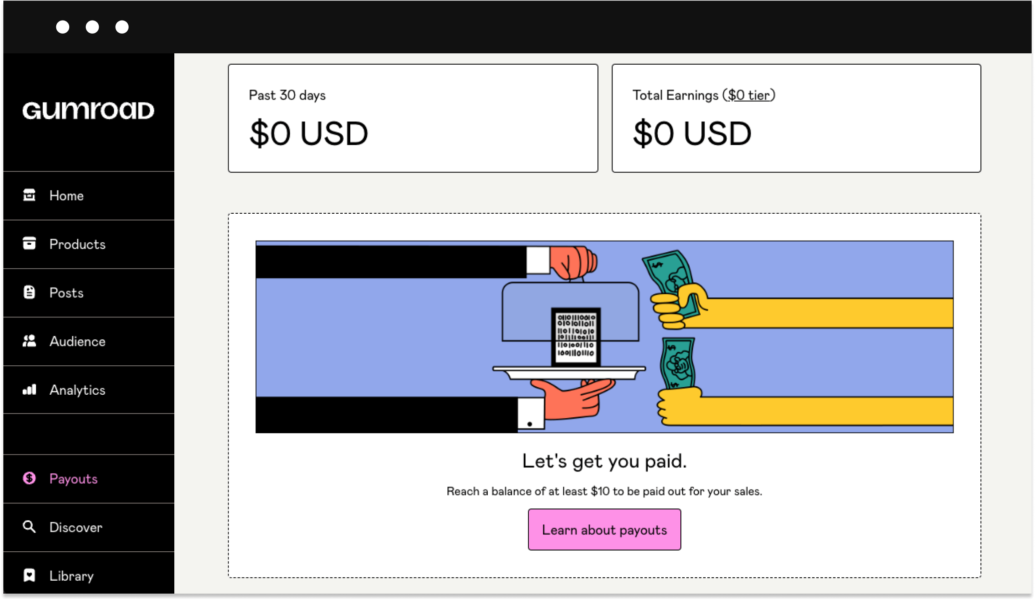
4. Not the best platform to sell courses and educational materials
In case your business is centered around courses and educational materials, this may heavily affect your final decision.
As I’ve already mentioned, Gumroad is an eCommerce platform primarily designed for selling digital products. It’s technically possible to sell physical products too, but their main focus is still on digital creators.
Even though you sell courses with Gumroad (in a form of a digital download), there’s no native course builder. There’s also no way to sell coaching and services or build online communities. This can be extremely frustrating for some people, especially if you’re looking to have all of those features in one place.
Why would you choose Podia over Gumroad?
1. Native course builder
Overall, there are five types of products that you can sell on Podia:
- Online course
- Digital download
- Webinar
- Bundle
- Coaching session
Without a doubt, online courses are Podia’s most popular type of product thanks to the built-in course builder. With its drag-and-drop feature, you can easily add various sections and lessons, and rearrange them however you like.
There’s also an option to add multimedia content, such as videos, audio files, and PDFs.
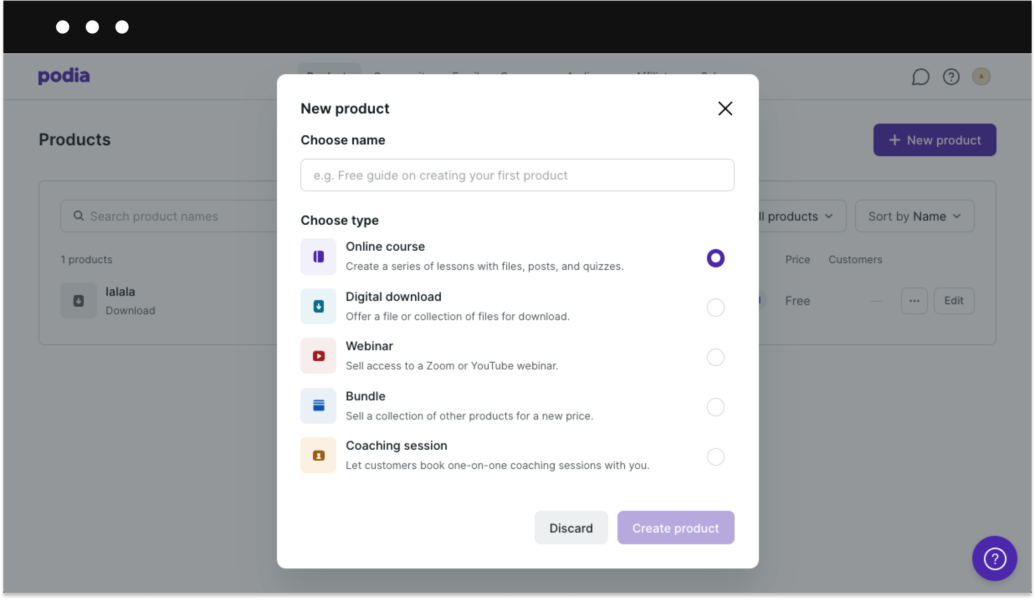
2. You can drag and drop your way to a website
In contrast to Gumroad, Podia allows you to create a bit more than just a product page.
Podia’s drag-and-drop editor allows you to add as many store pages as you need including an “About us” page with a customizable site search, a section with customer testimonials, or a “Link in bio” style page to promote your socials.
Moreover, you can create separate landing pages for each product in your store.
Sure, Podia’s store builder lacks basic customization features like store themes. But when compared to Gumroad, it certainly has an upper hand.

3. More ways to promote your products
When compared to Gumroad, Podia does a better job of helping sellers to promote their products and increase customer satisfaction. Apart from offering email marketing, discounts, and upselling, Podia also has built-in tools like coaching, and chat support. Plus, you’ll be able to launch your own referral program.
Again, most tools are centered around selling online courses, but they still look slightly more advanced than the ones offered by Gumroad.

4. Comprehensive pricing and instant payouts
Even though Gumroad doesn’t have a monthly fee, you still will be charged a commission depending on how many products you sell.
On the other hand, Podis has four pricing options. Each plan gives access to a different set of features and transaction fee percentages:
- Free plan with an 8% transaction fee.
- The Mover plan costs $33 and allows you to sell unlimited products.
- The Shaker plan costs $75 and offers all the same features + unlimited webinars and affiliate programs.
- The Earthquaker plan costs $166 and on top of everything else ensures priority support and onboarding calls.
The main disadvantage of Podia
If we set some obvious benefits aside, there are also a couple of dealbreakers that you need to be aware of.
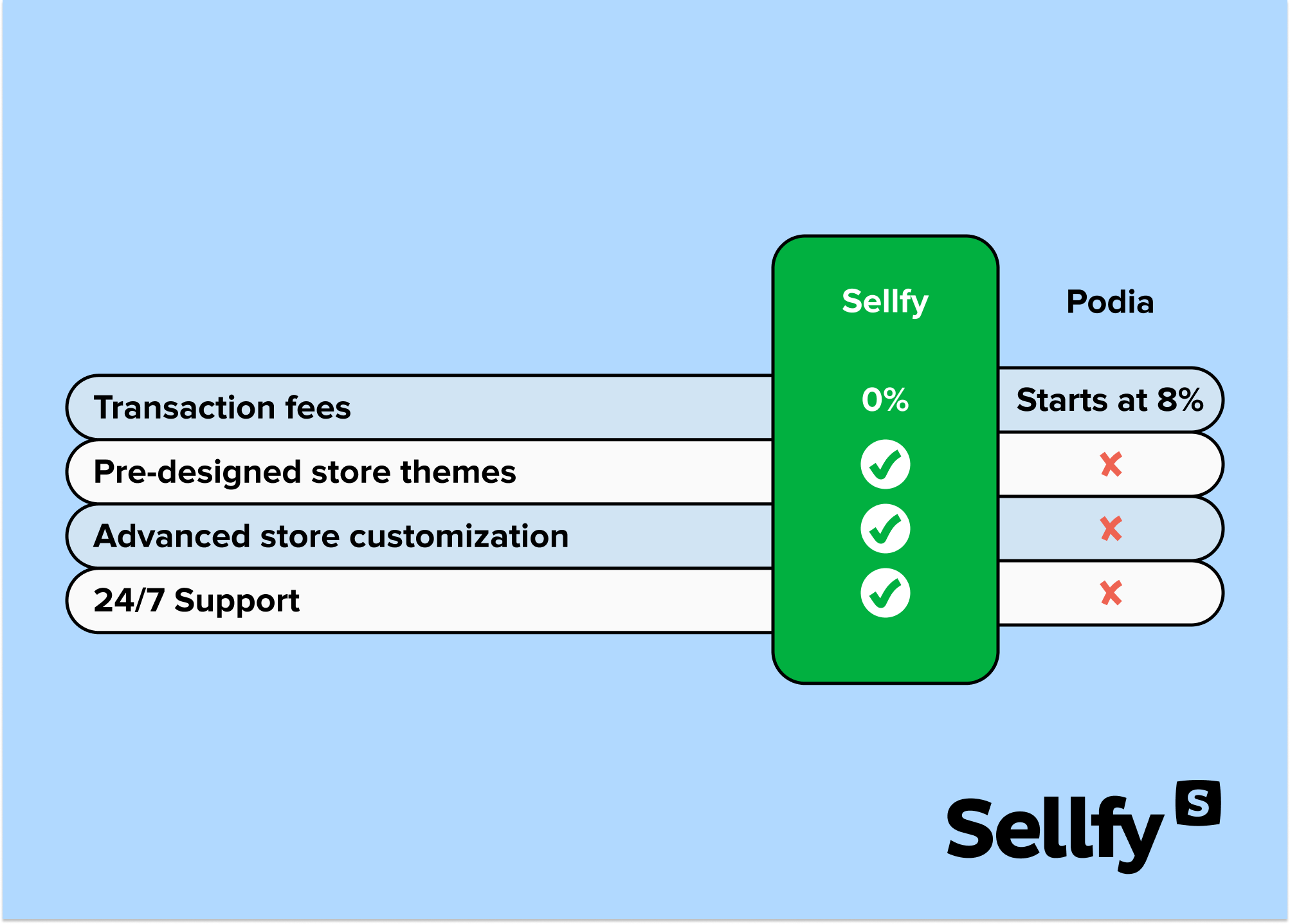
1. Their free plan is a joke
Similar to Gumroad, Podia offers a free plan that is… giving you almost nothing apart from the fact that there’s no subscription fee.
To be honest, Podia’s free plan looks more like an extended free trial. You get to try most of the features, but all you get is the possibility to sell just one product.
Moreover, you’ll have to pay an 8% commission on each sale. Sure, Gumroad has transaction fees too, but at least you get access to all available features.
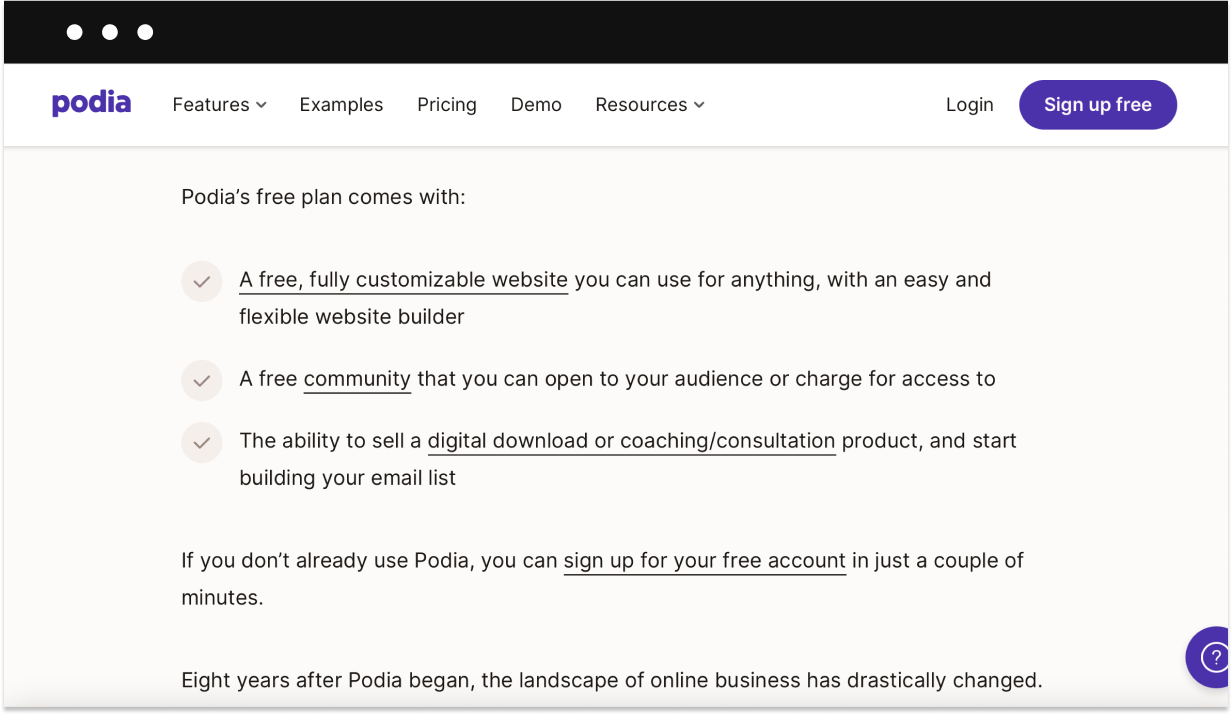
2. It’s just too expensive for what it is
Free plan aside, Podia’s paid plans appear to be a tad too pricy when compared to eCommerce solutions like Sellfy. Overall they offer three paid subscriptions with prices ranging from $39-179 per month.
With each upgrade, you can either get more available product categories like webinars, or extra services like priority support and onboarding calls.

3. Not enough built-in tools to grow your business
Podia markets itself as a feature-rich eCommerce platform, but in reality, it fails to deliver on multiple fronts.
One of the biggest disappointments is the lack of built-in eCommerce tools. With Podia, you get access to basic email marketing and social media integration, but that’s about it. There are no marketing automation features or advanced tracking options. This makes it difficult to gauge the effectiveness of your marketing campaigns and make necessary adjustments.
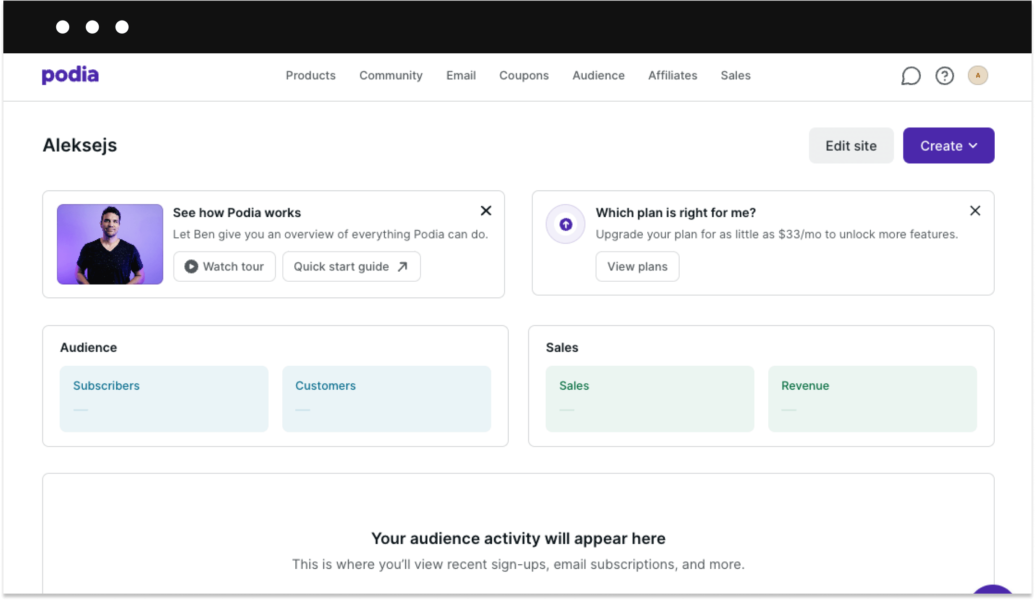
4. It wouldn’t hurt to have more customization options
In contrast to Gumroad, Podia’s store customization possibilities seem to be more advanced. But at a closer look, you’ll see that they’re simply not enough, especially when compared to some of the “cheaper” eCommerce platforms.
First of all, there are no store themes to choose from. So if you’re looking to create a website, you’ll have to design it yourself.
And by creating the design I mean adding a couple of pages, changing fonts, and colors, and uploading your logo — that’s where Podias customization possibilities end.

The question isn’t Gumroad vs. Podia — it’s why not Sellfy?
By now, you should have a clear understanding of what both platforms are really capable of.
If you’re looking for a quick and simple way to sell a couple of digital products, Gumroad is worth considering. However, if you are looking for a platform to build and sell online courses, Podia could fit you better
Before making the final decision, I’d like to share a few more reasons why choosing Sellfy over Gumorad or Podia could be a good idea:
More customization
First of all, Sellfy’s store customizer is a step above the competition, especially when compared to solutions like Podia or Gumroad. With Sellfy, you can either choose one of the pre-designed store themes (they all are free) or build a brand-new store from scratch.
The best part is that you can build a professional-looking online store without any coding experience, all you need to do is drag and drop different elements.
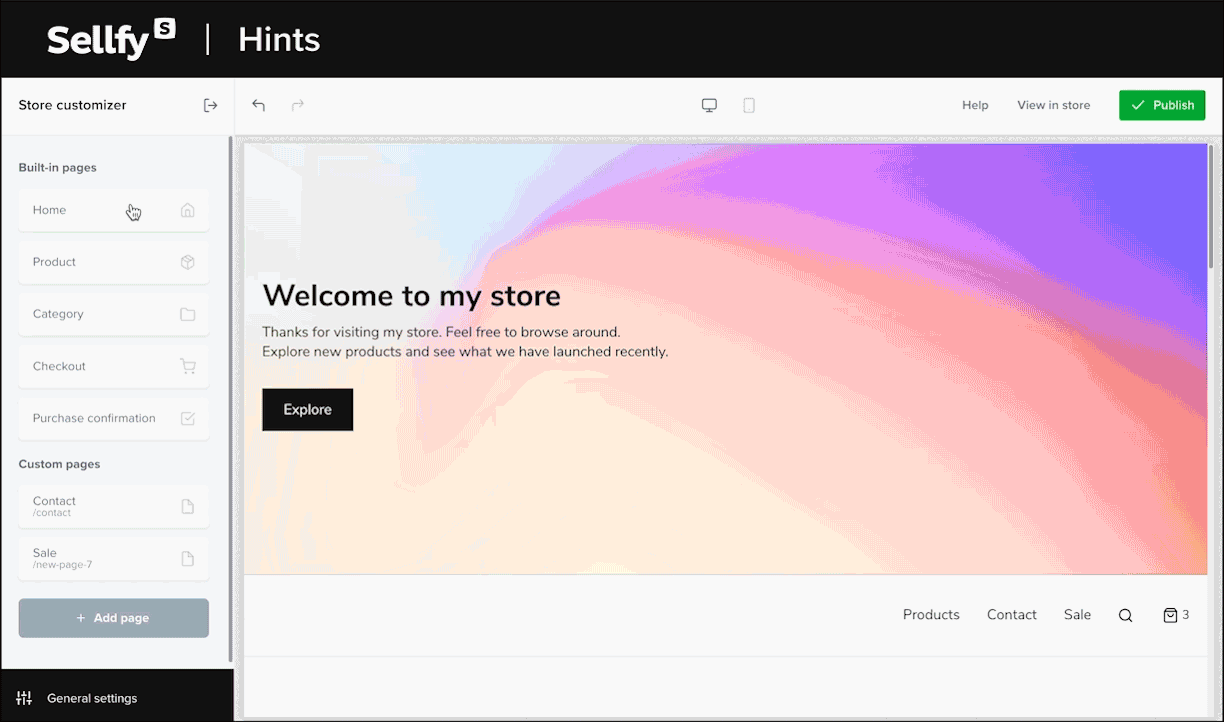
Better marketing features
If we’re being completely honest, both Podia and Gumroad offer any built-in functionality at all. Especially when it comes to marketing tools that are essential for generating leads.
Sellfy, on the other hand, has everything you need to launch and grow your online business, including email marketing, discounts & coupon codes, upselling, cart abandonment, and even pay-what-you-want pricing. Moreover, Sellfy’s store analytics feature offers robust reporting capabilities.
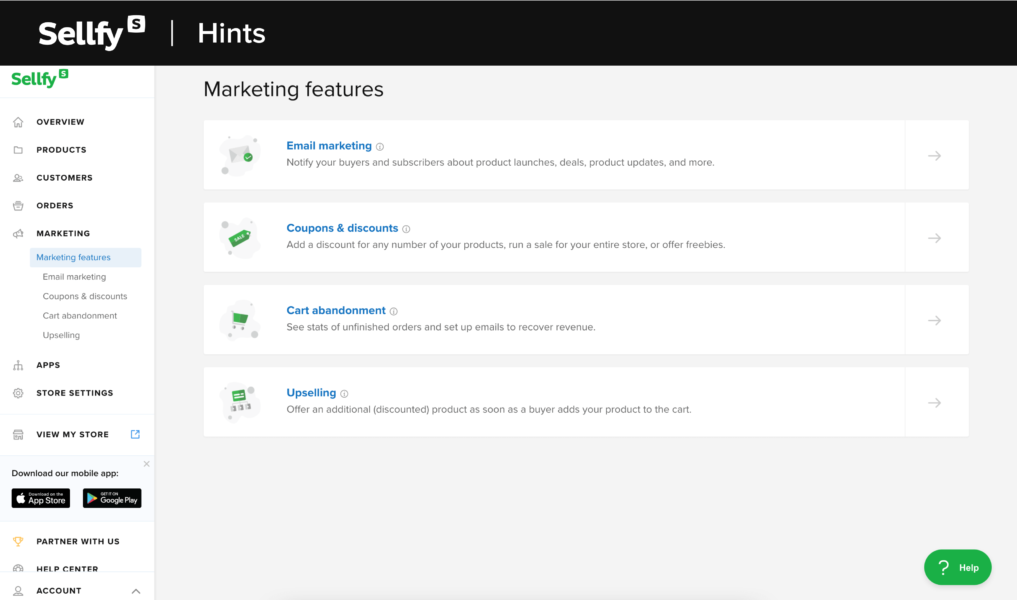
Effortless setup
With Sellfy, setting up a website for your courses or digital products is really a matter of minutes. The best part is that you don’t need any previous experience whatsoever to build a brand-new home for your digital downloads, online courses, or even print-on-demand merchandise.
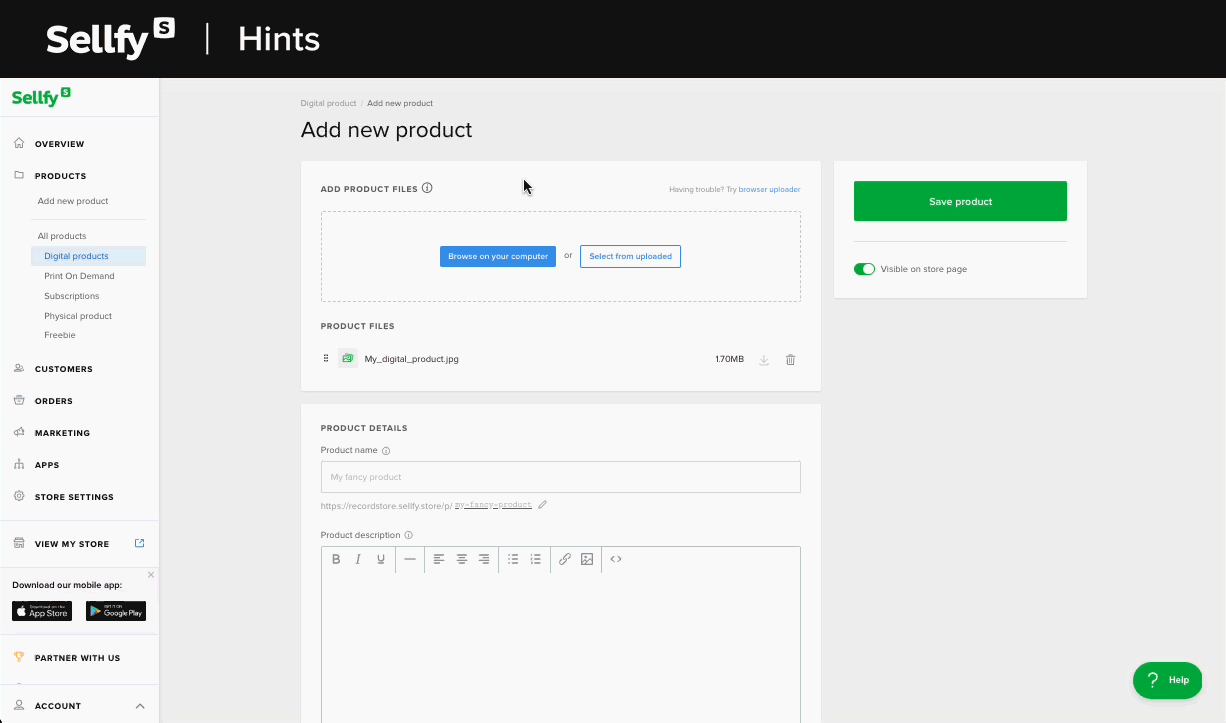
Fantastic customer support
There’s nothing more important than good customer support when it comes to launching your online store. Unlike Podia, Sellfy’s customer support team is available 24/7, and it’s really helpful too).
Sellfy creator and photographer Megan Hein agrees:
I was also blown away at how quick your customer support was to respond. I thought it would take a week or two before I heard back from them, but that immediate response kept my business up and running.
Make sure to check out more Stan Store comparison articles:
FAQ: Gumroad vs. Podia
Is Podia better than Gumroad?
The choice between Podia and Gumroad depends on your specific needs. Podia focuses on online courses and memberships, providing an all-in-one platform with features like course hosting and email marketing. Gumroad, on the other hand, caters to a broader range of digital products, making it suitable for creators with diverse product offerings. Consider your business requirements and the type of products you want to sell when making a decision.
Is there a better alternative to Podia and Gumroad?
Sellfy has proven to be a strong alternative to both Podia and Gumroad. It offers a user-friendly platform with zero transaction fees, customizable storefronts, and a wide range of digital products, including online courses. With its marketing features and global reach, Sellfy allows creators to monetize their content effectively and grow their online business.
Is Gumroad good for selling online courses?
Yes, Gumroad is a viable platform for selling online courses. It provides tools for creators to offer digital products, including video courses, ebooks, and more. However, its focus is not solely on courses like Podia, so creators may need to explore Gumroad’s additional features to determine if it suits their specific needs for marketing and selling courses.




